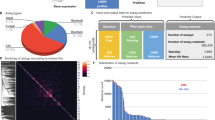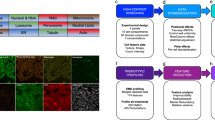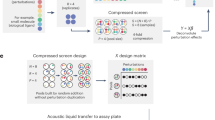Abstract
High-content screening is transforming drug discovery by enabling simultaneous measurement of multiple features of cellular phenotype that are relevant to therapeutic and toxic activities of compounds. High-content screening studies typically generate immense datasets of image-based phenotypic information, and how best to mine relevant phenotypic data is an unsolved challenge. Here, we introduce factor analysis as a data-driven tool for defining cell phenotypes and profiling compound activities. This method allows a large data reduction while retaining relevant information, and the data-derived factors used to quantify phenotype have discernable biological meaning. We used factor analysis of cells stained with fluorescent markers of cell cycle state to profile a compound library and cluster the hits into seven phenotypic categories. We then compared phenotypic profiles, chemical similarity and predicted protein binding activities of active compounds. By integrating these different descriptors of measured and potential biological activity, we can effectively draw mechanism-of-action inferences.
This is a preview of subscription content, access via your institution
Access options
Subscribe to this journal
Receive 12 print issues and online access
$259.00 per year
only $21.58 per issue
Buy this article
- Purchase on SpringerLink
- Instant access to full article PDF
Prices may be subject to local taxes which are calculated during checkout






Similar content being viewed by others
References
Haggarty, S.J. The principle of complementarity: chemical versus biological space. Curr. Opin. Chem. Biol. 9, 296–303 (2005).
Nichols, A. High content screening as a screening tool in drug discovery. Methods Mol. Biol. 356, 379–387 (2007).
Lang, P., Yeow, K., Nichols, A. & Scheer, A. Cellular imaging in drug discovery. Nat. Rev. Drug Discov. 5, 343–356 (2006).
Mitchison, T.J. Small-molecule screening and profiling by using automated microscopy. ChemBioChem 6, 33–39 (2005).
Blake, R.A. Target validation in drug discovery. Methods Mol. Biol. 356, 367–377 (2007).
Eggert, U.S. & Mitchison, T.J. Small molecule screening by imaging. Curr. Opin. Chem. Biol. 10, 232–237 (2006).
Carpenter, A. et al. CellProfiler: image analysis software for identifying and quantifying cell phenotypes. Genome Biol. 7, R100 (2006).
Giuliano, K.A., Haskins, J.R. & Taylor, D.L. Advances in high content screening for drug discovery. Assay Drug Dev. Technol. 1, 565–577 (2003).
Lee, S. & Howell, B.J. High-content screening: emerging hardware and software technologies. Methods Enzymol. 414, 468–483 (2006).
Spearman, C. “General intelligence”, objectively determined and measured. Am. J. Psychol. 15, 201–293 (1904).
Carroll, J.B. & Schweiker, R.F. Factor analysis in educational research. Rev. Educ. Res. 21, 368–388 (1951).
Floyd, F.J. & Widaman, K.F. Factor analysis in the development and refinement of clinical assessment instruments. Psychol. Assess. 7, 286–299 (1995).
Malinowski, E.R. Factor Analysis in Chemistry 1–432 (John Wiley and Sons, Inc., New York, 2002).
Stewart, D.W. The application and misapplication of factor analysis in marketing research. J. Mark. Res. 18, 51–62 (1981).
Tinsley, H.E.A. & Tinsley, D.J. Uses of factor analysis in counseling psychology research. J. Couns. Psychol. 34, 414–424 (1987).
Johnson, R.A. & Wichern, D.W. Applied Multivariate Statistical Analysis 426–542 (Prentice Hall, Inc., Upper Saddle River, New Jersey, USA, 2002).
Bender, A. & Glen, R.C. Molecular similarity: a key technique in molecular informatics. Org. Biomol. Chem. 2, 3204–3218 (2004).
Johnson, M., Lajiness, M. & Maggiora, G. Molecular similarity: a basis for designing drug screening programs. Prog. Clin. Biol. Res. 291, 167–171 (1989).
Maggiora, G.M. On outliers and activity cliffs–why QSAR often disappoints. J. Chem. Inf. Model. 46, 1535 (2006).
Hert, J. et al. New methods for ligand-based virtual screening: use of data fusion and machine learning to enhance the effectiveness of similarity searching. J. Chem. Inf. Model. 46, 462–470 (2006).
Carrieri, A., Centeno, N.B., Rodrigo, J., Sanz, F. & Carotti, A. Theoretical evidence of a salt bridge disruption as the initiating process for the alpha1d-adrenergic receptor activation: a molecular dynamics and docking study. Proteins 43, 382–394 (2001).
Schaper, K. Free-Wilson-type analysis of non-additive substituent effects on THPB dopamine receptor affinity using artificial neural networks. Quant. Struct. Act. Relat. 18, 354–360 (1999).
Gräfe, U. et al. Aurantimycins, new depsipeptide antibiotics from Streptomyces aurantiacus IMET 43917. Production, isolation, structure elucidation, and biological activity. J. Antibiot. (Tokyo) 48, 119–125 (1995).
Matsumoto, N. et al. Diperamycin, a new antimicrobial antibiotic produced by Streptomyces griseoaurantiacus MK393–AF2. I. Taxonomy, fermentation, isolation, physico-chemical properties and biological activities. J. Antibiot. (Tokyo) 51, 1087–1092 (1998).
Yuan, Y., Men, H. & Lee, C. Total synthesis of kendomycin: a macro-C-glycosidation approach. J. Am. Chem. Soc. 126, 14720–14721 (2004).
Manabe, T., Yoshimori, T., Henomatsu, N. & Tashiro, Y. Inhibitors of vacuolar-type H(+)-ATPase suppresses proliferation of cultured cells. J. Cell. Physiol. 157, 445–452 (1993).
Kawashima, J. et al. Antitumor activity of heptelidic acid chlorohydrin. J. Antibiot. (Tokyo) 47, 1562–1563 (1994).
Samuelsson, M.K., Pazirandeh, A., Davani, B. & Okret, S. p57Kip2, a glucocorticoid-induced inhibitor of cell cycle progression in HeLa cells. Mol. Endocrinol. 12, 1811–1822 (1999).
Bielawski, K., Winnicka, K. & Bielawska, A. Inhibition of DNA topoisomerases I and II, and growth inhibition of breast cancer MCF-7 cells by ouabain, digoxin and proscillaridin A. Biol. Pharm. Bull. 29, 1493–1497 (2006).
Ramirez-Ortega, M. et al. Proliferation and apoptosis of HeLa cells induced by in vitro stimulation with digitalis. Eur. J. Pharmacol. 534, 71–76 (2006).
Pauw, P.G., Kaffer, C.R., Petersen, R.J., Semerad, S.A. & Williams, D.C. Inhibition of myogenesis by ouabain: effect on protein synthesis. In Vitro Cell. Dev. Biol. Anim. 36, 133–138 (2000).
Schweighoffer, T. et al. Cytometric analysis of DNA replication inhibited by emetine and cyclosporin A. Histochemistry 96, 93–97 (1991).
Horiuchi, S. et al. Expression of progesterone receptor B is associated with G0/G1 arrest of the cell cycle and growth inhibition in NIH3T3 cells. Exp. Cell Res. 305, 233–243 (2005).
Owen, G.I., Richer, J.K., Tung, L., Takimoto, G. & Horwitz, K. Progesterone regulates transcription of the p21(WAF1) cyclin-dependent kinase inhibitor gene through Sp1 and CBP/p300. J. Biol. Chem. 273, 10696–10701 (1998).
Nidhi, G., Glick, M., Davies, J.W. & Jenkins, J.L. Prediction of biological targets for compounds using multiple-category Bayesian models trained on chemogenomics databases. J. Chem. Inf. Model. 46, 1124–1133 (2006).
Checchi, P.M., Nettles, J.H., Zhou, J., Snyder, J.P. & Joshi, H.C. Microtubule-interacting drugs for cancer treatment. Trends Pharmacol. Sci. 24, 361–365 (2003).
Li, L. et al. Antitumor agents 155. Synthesis and biological evaluation of 3′,6,7-substituted 2-phenyl-4-quinolones as antimicrotubule agents. J. Med. Chem. 37, 3400–3407 (1994).
Shi, Q., Chen, K., Morris-Natschke, S.L. & Lee, K.H. Recent progress in the development of tubulin inhibitors as antimitotic antitumor agents. Curr. Pharm. Des. 4, 219–248 (1998).
Tong, Y.G. et al. Pseudolarix acid B, a new tubulin-binding agent, inhibits angiogenesis by interacting with a novel binding site on tubulin. Mol. Pharmacol. 69, 1226–1233 (2006).
Clemons, P.A. Complex phenotypic assays in high-throughput screening. Curr. Opin. Chem. Biol. 8, 334–338 (2004).
Loo, L.H., Wu, L.F. & Altschuler, S.J. Image-based multivariate profiling of drug responses from single cells. Nat. Methods 4, 445–453 (2007).
Olah, M. et al. in Chemoinformatics in Drug Discovery WOMBAT: World of Molecular Bioactivity (ed. Oprea, T.I.) 223–239 (Wiley-VCH, New York, 2004).
Jenkins, J.L., Bender, A. & Davies, J.W. In silico target fishing: predicting biological targets from chemical structure. Drug Discov. Today Technol. 3, 413–421 (2007).
Bender, A. & Glen, R.C. A discussion of measures of enrichment in virtual screening: comparing the information content of descriptors with increasing levels of sophistication. J. Chem. Inf. Model. 45, 1369–1375 (2005).
Bender, A., Mussa, H.Y., Reiling, S. & Glen, R.C. Similarity searching of chemical databases using atom environment descriptors (MOLPRINT 2D): evaluation of performance. J. Chem. Inf. Model. 44, 1708–1718 (2004).
Glen, R.C. et al. Circular fingerprints: flexible molecular descriptors with applications from physical chemistry to ADME. IDrugs 9, 199–204 (2006).
Nettles, J.H. et al. Bridging chemical and biological space: “target fishing” using 2D and 3D molecular descriptors. J. Med. Chem. 49, 6802–6810 (2006).
Acknowledgements
We thank L. Martell, M. Thoma, J. Nettles, B. Dwyer and M. Pflumm for insightful comments and discussions, G. Paris for assembly of the climax screening collection, A. Salic (Harvard Medical School) for the gift of rhodamine azide, C. Mickanin and S. Zhao for automation support, and Q. Yang for database support. D.W.Y. and A.B. are both Novartis Presidential Postdoctoral Fellows. Work in the T.J.M. lab is supported by US National Institutes of Health grant CA78048.
Author information
Authors and Affiliations
Contributions
D.W.Y., A.B., J.L.J., T.J.M. and Y.F. conceived the work. J.H., D.W.Y. and E.M. performed experiments. D.W.Y. developed and implemented factor analysis of HCS data. A.B. performed ligand-target and compound structure analysis. D.W.Y. and A.B. performed integrated statistical analysis of biological and chemical data. D.W.Y., T.J.M. and Y.F. analyzed phenotypes. C.Y.T. performed cell cycle analysis. J.A.T. and M.L. contributed to experimental design and interpretation. G.-W.C. assisted in data processing and analysis. D.W.Y. and A.B. wrote the paper with assistance from J.L.J., T.J.M. and Y.F.
Corresponding authors
Supplementary information
Supplementary Text and Figures
Supplementary Figures 1–6, Supplementary Table 1 and Supplementary Methods (PDF 1158 kb)
Supplementary Data 1
Workbook containing results from the factor analysis. (XLS 86 kb)
Supplementary Data 2
Table of hit data. (XLS 445 kb)
Rights and permissions
About this article
Cite this article
Young, D., Bender, A., Hoyt, J. et al. Integrating high-content screening and ligand-target prediction to identify mechanism of action. Nat Chem Biol 4, 59–68 (2008). https://doi.org/10.1038/nchembio.2007.53
Received:
Accepted:
Published:
Issue date:
DOI: https://doi.org/10.1038/nchembio.2007.53
This article is cited by
-
High-content analysis identified synergistic drug interactions between INK128, an mTOR inhibitor, and HDAC inhibitors in a non-small cell lung cancer cell line
BMC Cancer (2024)
-
A statistical framework for high-content phenotypic profiling using cellular feature distributions
Communications Biology (2022)
-
Orthogonally-tunable and ER-targeting fluorophores detect avian influenza virus early infection
Nature Communications (2022)
-
Rapid statistical discrimination of fluorescence images of T cell receptors on immobilizing surfaces with different coating conditions
Scientific Reports (2021)
-
Advanced identification of global bioactivity hotspots via screening of the metabolic fingerprint of entire ecosystems
Scientific Reports (2020)



